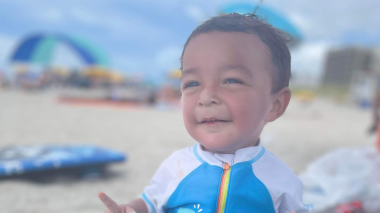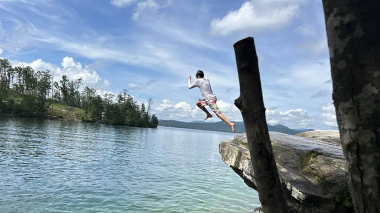The weather is heating up, which means beach trips and pool days are on the horizon. But these warm-weather activities can also bring common questions about water safety.
If you’re traveling to your favorite vacation spot, venturing out for a day on the lake or just hanging out at your neighborhood pool, our experts at Atrium Health Levine Children’s have a few tips to help you and your family swim safely this summer.
Know Your Role
According to Safe Kids Worldwide, 918 children under the age of 19 drowned in 2018, and more than 7,000 were seen in the emergency department.
Shannon Wilfong, pediatric trauma injury prevention coordinator at Atrium Health’s Levine Children's Hospital, says accidental injury – including drowning – is the leading cause of death among preventable injuries for children ages 1-4 years old.
“I have heard so many families who have experienced a traumatic event say they never thought it would happen to them – until it did,” Wilfong says. “Our job as adults is to protect our children.”
Jennifer Davis Prabhu, MD, pediatrician at Atrium Health Levine Children’s Midtown Pediatrics, says drowning and near-drowning incidents often happen when you don’t expect anyone to be in the pool.
“When swim time is over, make sure gates are secure and doors are locked. That way nobody can access the pool and think they can swim when no one is watching,” Dr. Prabhu says.
Tips for Safe Swimming
Although the risk for water-related injuries is very much a reality, there are several things you can do to help kids safely enjoy their time in the water. Here are a few recommendations to keep in mind:
- Have a designated water watcher (even if you don’t think anyone will be in the pool). “The water watcher becomes in charge of all the children who are swimming or in the water,” Dr. Prabhu says. When it’s time to switch out, Dr. Prabhu suggests using a verbal hand off to the next water watcher by saying something like, “It’s your turn now.” Wilfong and Dr. Prabhu both add you can wear a water watcher tag around your neck (like a whistle or lanyard) to remind yourself that you are on watch. Switching water watchers every 10 to 15 minutes is a smart way to always keep fresh eyes on the water.
- Watch without distraction. Most drownings are silent with little to no splashing, waving or screaming, so it’s important to stay aware. “Put your cell phones down and keep your eyes on the water,” Wilfong says.
- Introduce water safety early. Remind your child about the importance of following water rules – such as entering the water feet first and obeying lifeguards. Wilfong also suggests enrolling kids in swimming lessons to equip them with the skills they need to help them to be smart and safe around the water while giving them a little confidence. “It also gives you a peace of mind,” Wilfong says.
- Be proactive. When you go to a new place, like visiting family or at a vacation rental home, check locks and make sure the pool area is secure. “Keeping a cell phone nearby in case of emergencies and learning CPR are all safety measures you can take to ensure you and your family have a fun and safe summer,” Wilfong says.
- Don’t rely on flotation devices. When it comes to water, choosing the correct PFD (personal flotation device) for the appropriate water activity is crucial. Making sure your child's PFD fits properly based on their weight and body size is also important. “Life jackets and arm bands or puddle jumpers are not foolproof safety devices,” Wilfong says. “These items can unexpectedly deflate or come undone, creating a drowning hazard.” Dr. Prabhu adds that children should wear a flotation device when on a boat in open water, even if they’re not planning on swimming.
- Don’t swim alone. No one should ever swim alone; even older kids should have a swimming buddy. “I remind my adolescent patients to not swim alone or under the influence,” Dr. Prabhu says.
Year-Round Water Safety
“People think drowning only happens at the pool or in the ocean, but a lot of incidents occur in the home,” Wilfong says. Young children can drown in as little as one inch of water. From sinks and toilets to coolers and buckets, any amount of water can be dangerous. Empty buckets and kiddie pools after use and never leave children unattended when they are in or near water.
Fun in the Sun
Keep kids safe from the sun while they’re splashing around. Use sunscreen that blocks both UVA and UVB rays and has an SPF of 15 or higher. And be sure to apply sunscreen 15 minutes before you go outdoors or in the water and reapply sunscreen every 2 hours (even on cloudy days). You can also wear sunglasses to protect your eyes from UV rays and reduce the risk of cataracts.
If you have any questions about water and sun safety, ask your pediatrician. You can find a pediatrician here.



